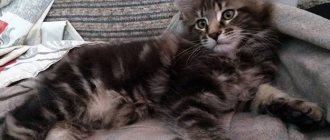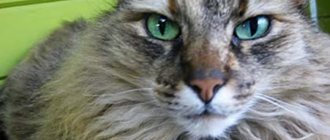How to determine
A cat's withers are located on the back side of the spine. Its central part is a point in front of the shoulder blades, which can be easily felt with your fingers by placing them above the pet’s front paws.
If after the photo you still haven’t figured out where the cat’s withers are, you can use another method. To do this, you need to grab the base of the front paws with one hand and hold it up, squeezing until a thick fold of skin is clamped in your fist. After this, you need to press your hand with a fold of skin to the body, where the hard bones of the shoulder blades will be felt - this will be the scruff.
Despite the reduced sensitivity of the skin, this place on the animal’s body is quite problematic because it is located next to the neck. Any serious injury to this area can cause health problems for your pet. Such damage most often occurs during mating, since the cat holds the cat's scruff with its paws during the process. It doesn’t always come to wounds, but sometimes this happens, so it is important to pay attention to this point and, if necessary, take appropriate measures.
This is interesting: Are there red cats?
Itching caused by helminths
There are a large number of varieties of parasitic worms that take up residence in a cat’s body. They can be:
- round;
- flat;
- tape.
Usually at the very beginning of infection it is difficult to consider any of its symptoms, but after a while the animal:
- loses appetite and activity;
- becomes restless;
- Constantly licks and itches.
Worms found in the intestines are considered almost harmless.
Difficulties with your pet’s health arise when there are too many helminths and their larvae begin to migrate.
The movement of worms throughout the animal’s body is accompanied by the following symptoms:
- sudden weight loss, increased fatigue, growth retardation in small pets;
- disheveled wool;
- enlarged liver and icteric staining of visible mucous membranes;
- disruption of the digestive system, expressed in constipation, vomiting, diarrhea;
- appearance of cough;
- discharge from the eyes;
- itching in the anus;
- presence of blood in feces;
- premature birth or miscarriage in cats;
- convulsions and paresis of the limbs.
The cat may not notice the presence of parasites in the body in small quantities. However, their increase will not only exhaust the animal, but will also lead to its death. The harm caused to pets by worms can be completely different :
- eating lymph, tissue and blood;
- release of substances that promote intoxication;
- damage to the mucous membranes by suction cups, leading to internal bleeding.
After the worms die, decomposition products are formed that poison the animal’s body.
The appearance of parasites leads to metabolic disorders, as a result of which the cat’s skin becomes dry and dandruff appears on it. Just like an allergic reaction, these factors are accompanied by itching, which causes the animal to scratch its neck until it bleeds. A pet can become infected with helminths in the following ways :
- eating raw meat or fish (especially river fish);
- flea bites;
- contacts with other animals.
To prevent itching, which causes painful scratching, animal owners need to regularly take a preventive course using anthelmintic medications.
Why is it necessary to know where a cat's withers are?
For preventive purposes, it is sometimes necessary to treat fleas and worms on a cat. This applies even to those animals that do not leave the house at all. You can bring the parasite into your apartment with your shoes.
As a rule, purrs meet their beloved owners at the doorstep and sense their approach in advance. So there is little chance of avoiding contact with the parasite. He walked on the dirty floor, his paws peeled off, and he became infected.
Many lovers of these animals know where the withers of a cat are. However, the information will be useful to those who just got such a pet and don’t really know what to do with it.
The scruff of the neck is the place where the animal cannot crawl out. This is the best option for applying flea and tick treatment. It is necessary to squeeze a few drops of the solution directly onto the skin, after parting the fur. This is especially true for very fluffy breeds.
If it is difficult for you to see where the cat’s withers are, our photos will help with this. This is the junction of the cervical and dorsal spine, just above the shoulder blades. The scruff is easy to feel with your hand.
The skin in this area is easily pulled back. Don't worry about the animal being in pain. The mother carries small kittens, taking them by this skin. The animal will even feel some maternal care and calm down.
There is no need to look for where the withers of different breeds of cats are. Everyone has the same body structure. This place is also the best option for administering the medicine by injection. This is how they mostly do vaccinations and administer medications against ear mites.
The veterinarian holds tightly by the scruff of the neck and the animal has little chance of breaking free, as you can see by looking at the photo of the withers of cats. In addition, if such attempts are made, the chances of injury are zero.
Therefore, you cannot hold the animal by its paws or tail. In the latter case, the animal will be in great pain. The tail contains many nerve endings and blood vessels.
Withers and training
The withers area can be used not only to treat the animal. With its help, you can influence the cat’s behavior and “educate” it. By correctly influencing the area, you can stop the animal’s aggression and show “who’s boss.”
Procedure:
- Carefully, but firmly and confidently, grab the cat by the withers with your fingers. It is very important not to worry in order to demonstrate your strength and authority.
- Without releasing the withers, lightly press the animal to the floor. This will show the cat that the owner is “more important.” At the same time, you can also confidently and clearly pronounce some command or prohibition - for example, “no”, “no”, etc. There is no need to raise your voice, but hissing like an angry cat is very effective. So, the pet will understand that the owner is dissatisfied with its behavior.
- You can release the cat only when its muscles are completely relaxed. After this, you can “talk” a little more with the animal, release the grip, stroke and praise.
Important! The withers are a fairly sensitive area, so you should not use too much force and cause pain to the animal. It is important to do the above actions authoritatively, but carefully.
But you cannot lift an adult specimen up by the scruff of the neck. It is especially important to explain this to children. If you lift it with your hand behind the withers, then you must support the pet’s body with your other hand. And if there is any suspicion of injury to the withers area, the animal must be taken to the veterinarian immediately.
What is the withers used for?
The owner can use the features of the withers when raising and caring for his pet.
Impact on the withers during training and education
Any cat owner should know how pressure on the withers affects their pet. If possible, this knowledge can be used for training or raising a pet, as well as suppressing aggression. As an example, we can take the development of the necessary reflexes. If the pet has performed some unnecessary action (sharpening its claws on the sofa or making a puddle in the wrong place), the following algorithm is used:
- Carefully, quite firmly, take the cat by the withers. With this gesture, the owner makes it clear that he is a strong leader. This must be done for the animal to show obedience.
- Lightly press the animal to the floor. At this time, firmly and clearly, without raising your voice, pronounce the word “impossible” or “bad.” Many owners begin to hiss instead of words, following the example of angry cats. By this, the owner brings his pet to the understanding that he is dissatisfied with his behavior or trick.
- Keep the cat in this position until the animal’s muscles begin to relax. As soon as the pet becomes soft and pliable, it can be released.
- Next, you need to praise your pet or treat it with a treat.
Do not forget that the educational moment should not cause pain in the animal (holding the withers itself does not bring discomfort).
The same method of education can be used if the cat shows aggression. From the outside it looks strange, but the method really helps. It only takes 3-5 minutes to hold the cat by the withers, and after the second or third time the animal begins to understand why its owner is dissatisfied.
Even for training purposes, you should not grab a cat by the scruff of the neck and lift it high, much less shake it in this position. This can cause injury to the animal, which will result in significant health problems.
How to use the withers to treat a cat
Veterinarians carry out various procedures; the animal’s withers become the location of many of them.
Application of medications
A striking example of the use of the withers for medicinal purposes is such a moment as ridding an animal of fleas. For this, special drops are used. The place where they are applied to the withers is determined by the fact that the cat cannot reach here with its tongue or paw, which means it will also not be able to lick off the medicine.
Some medications are applied to the cat's withers, because from here she will not be able to lick them off
Injections
The withers are used for subcutaneous injections. These could be medications for a sick animal or vitamins. The choice of location is determined by the following circumstances:
- An injection under the skin at the withers does not cause pain, since this is an area of low sensitivity.
- The drug injected into the withers penetrates the bloodstream faster, since subcutaneous fat has a loose structure and high absorbency.
If possible, the injection into the withers should be carried out with an assistant who will hold the animal.
The withers are used as a site for subcutaneous injections
At the moment of injection, the needle should not go deeper than a third. This rule must be observed, since violation can harm the cat. If the owner is not confident in his ability to give injections, then you can use an insulin syringe, which has a small and thin needle. If this option is not suitable, then it would be useful to contact a specialist. You should not experiment with your pet's health.
Video: how to give a cat an injection at the withers
Structure
When treating cats for various diseases, drops or injections are often prescribed on the withers. Where is this place in the animal and how to correctly carry out such procedures? Read the article about where the cat’s withers are, as well as how to apply medicine to it.
Where is
The withers are the part of the animal's body located behind its head, where the neck ends and the back begins. It is this place that the common people call “shkirka”.
If you want to know exactly where a cat's withers are, look at how these animals carry their babies. Pets always do this the same way. The place where a mother grabs her kittens with her teeth is the withers.
Holds the cat by the scruff of the neck during mating.
Structure
So, we found out what the withers are and where they are located in a cat. How does this part of the animal’s body work? The bone base of the withers is formed by the first 5 thoracic vertebrae. They have spinous processes that give shape to this part of the body.
The skin in this area of the animal is very thin and elastic. That is why kittens do not experience any pain at the moment when the mother takes them by the scruff of the neck with her teeth. The spinous processes of the vertebrae have different heights.
Due to this, the animal’s withers have a slightly arched shape.
Under the skin in this place there is fatty tissue. Next come the muscles (semispinalis, rhomboid, trapezius, etc.). The joints at the withers are found only in the spine itself. A cat's shoulder blades are attached to the body solely with the help of muscles and tendons. This determines the animal’s extraordinary flexibility and its ability to make almost lightning-fast jumps.
Due to the special method of attaching the forelimbs, it is not advisable to pick up a cat by them and lift him up by weight. The animal experiences severe discomfort. It is much more correct to hold your pet behind the shoulder blades in the chest area when lifting.
The withers of a cat, where the skin is not too sensitive, is still a relatively problematic place. After all, next to it is the animal’s neck. Any serious injury to this part of the body can lead to health problems for the pet or even its death. Therefore, in case of damage to the withers, owners should take their pet to the veterinarian as soon as possible.
Advantage of drops
Until recently, fleas could only be removed from a cat using various types of shampoos. Today, pet stores sell all kinds of sprays against parasites, as well as drops in capsules. When using the latter, the medicine is usually applied precisely to the withers of the animal.
This method guarantees that the cat will not lick the drug, get it with its paw and get poisoned. It’s clear where the cat’s withers are. Essentially, this is the highest point of the back. Therefore, after application, the medicine is distributed relatively evenly by gravity over the animal’s back and sides, which ensures the best effect.
Of course, for the drug to be as effective as possible, it must be used correctly.
Thus, now the reader knows where the cat’s withers are. How to find it if you need to use medication is a simple question. However, when using the drops themselves, several important rules should be followed.
Firstly, the cat should not be bathed for 2-3 days before using the medicine and for 2-3 days after that. Secondly, before using the drops, the animal’s withers must be carefully examined. If there are large lesions and wounds on it, it is better not to use the medicine.
If the circumstances are unsuccessful in this case, the insecticide may enter the animal’s bloodstream, which will lead to poisoning.
The cat may jerk during the procedure to escape, and the drops will fall too low on the body. As a result, the animal will subsequently be able to reach them. Wait until your pet calms down.
The instructions for applying the drops are simple. In order to do everything correctly:
- put on medical rubber gloves;
- feel where the cat’s withers are;
- spread the fur on the animal’s neck closer to the base of the skull;
- completely squeeze the product out of the capsule onto the skin in the area of the highest spinous process;
- lightly rub the drops so that they do not flow to the side.
After using the drug, as already mentioned, it is not recommended to bathe the animal for several days. You should also not brush your cat.
And, of course, you should not stroke your pet’s head or back for a couple of days. Otherwise, the medicine may get on your hands and subsequently cause poisoning in the owner.
Some types of flea medications can also irritate human skin.
A very common medical procedure for treating animals is subcutaneous injections. Such injections are less painful than intramuscular ones and provide a high speed of action of the drugs. For cats, subcutaneous injections are given precisely in the area of the withers.
READ How a cat gives birth and how the owner can help his pet
After all, here the animal’s skin is thinnest and most elastic. In addition, the cat’s skin in this area is less sensitive. And therefore, your pet will not experience much pain. In addition, as a result of grabbing a cat by the scruff of the neck, its instinct of submission is activated.
Therefore, the animal resists less.
It is best to inject medicine into an animal with an assistant. This procedure is carried out as follows:
- The cat is placed on its side on the table with its back to itself. The assistant must hold the animal by the hind legs and back.
- With the left hand, the skin on the withers is pulled back with a fold.
- The injection is made by pointing the needle parallel to the back.
If there is no assistant, you don’t have to place the cat on its side. In this case, it will be more convenient to place it on the floor or on the sofa. The injection is given to the animal by pressing it with the elbow of the left hand and at the same time pulling the skin with the fingers. Finding where the cat's withers are will also be easy in this case. The injection itself is done by inserting the needle no more than a third. Only a children's or insulin syringe can be used for injection.
Most often, such damage occurs in animals during mating. A cat rarely leaves wounds on a cat’s withers, but sometimes this does happen. To treat the area around the lesion, you first need to trim the fur. Next, you should rinse the wound with hydrogen peroxide. You can also use Terramycin spray or brilliant green.
Old wounds with signs of inflammation should be treated with antibiotics. This could be, for example, Misofenom ointment. It is applied to a napkin and applied to the wound. Then a bandage is applied. But, of course, it’s better not to let things get to the point of inflammation. If the damaged area is swollen and red, or there is pus coming out of it, you should immediately contact a specialist.
Interesting fact
Where the withers are located in cats, and what injuries the pet most often receives in the scruff area is therefore clear. As you can see, this place is significant for the animal’s body. Among other things, the withers also have one very interesting property.
The fact that kittens calm down immediately after a cat takes them by the scruff of the neck, hang calmly and do not try to escape is well known. Why is this happening? Why do kittens hang in their mother’s teeth like lifeless “bags” in the fetal position? In fact, this behavior is primarily due to the presence of a special zone in the cat’s brain.
As soon as the animal is taken by the scruff of the neck, certain impulses begin to flow from here, calming it. At the same time, the cerebellum gives the cat a signal to take a characteristic pose.
Scientists believe that such a mechanism was developed in these animals during the process of evolution. After all, a cat will not simply transfer its offspring from place to place. She acts in this way only when her children are in any danger. A screaming, attention-grabbing kitten in nature simply has a significantly reduced chance of survival.
Instead of a conclusion
Well, we hope we have answered the question in sufficient detail about what the withers are and where they are located in a cat. This place differs from the rest of the animal’s body primarily in its more elastic and at the same time less sensitive skin.
But, despite this fact, it is, of course, not worth taking an adult animal by the scruff of the neck and lifting it by weight. The body weight of an adult cat is much greater than that of a kitten.
And despite the not too high sensitivity of the skin, the animal, when treated in this way, will, of course, feel severe discomfort or even pain.
So, we found out what the withers are and where they are located in a cat. How does this part of the animal’s body work? The bone base of the withers is formed by the first 5 thoracic vertebrae. They have spinous processes that give shape to this part of the body. The skin in this area of the animal is very thin and elastic. That is why kittens do not experience any pain at the moment when the mother takes them by the scruff of the neck with her teeth. The spinous processes of the vertebrae have different heights. Due to this, the animal’s withers have a slightly arched shape.
The withers of a cat, where the skin is not too sensitive, is still a relatively problematic place. After all, next to it is the animal’s neck. Any serious injury to this part of the body can lead to health problems for the pet or even its death. Therefore, in case of damage to the withers, owners should take their pet to the veterinarian as soon as possible.
Withers injuries
Under some circumstances, a cat may be injured in the withers area. This may happen due to the following reasons:
- skin diseases or scratching associated with parasites (fleas, ticks);
- wounds formed during a fight with other cats (cats) - bites, scratches;
- bites that may appear on the withers of females during mating;
- burns or cuts (an animal may be accidentally doused with boiling water, or a cat may cut its withers on a sharp object);
- wounds that may occur due to incorrect injection.
The wound must be treated immediately. Simple hydrogen peroxide is suitable for this. You can also use greenery. Next, you need to remove the hair around the wound. Only then apply a bandage.
If the wound begins to become inflamed, it should be regularly treated with an antiseptic (for example, chlorhexidine). At the slightest manifestation of suppuration, contacting a specialist is inevitable.
If in any situation you have to lift the cat by the withers, you should hold it by the chest with your other hand. This will avoid injury to the cervical spine due to the significant weight of the animal. The rules for lifting an animal must be explained to children. Unknowingly, they can cause pain to your pet.
The withers of a cat are radically different from other parts of the body. First of all, this area has elastic skin with low sensitivity. Meanwhile, it is forbidden to lift an adult animal by the scruff of the neck. The withers are used to treat the animal, such as applying flea treatment or administering injections. But any damage to the withers entails a number of health problems, so it is important to promptly treat the wounds and show the animal to a veterinarian.
(3 votes, average: 5 out of 5)
This is interesting: Instructions for use of Essentiale for cats
Injuries to the scruff of the neck
Injuries to the scruff of the neck are quite rare, and their main cause is mating, during which the male holds the female with his teeth.
If damage to the skin on the back of the neck occurs, you must:
- thoroughly treat with antiseptic agents and, if necessary, cut the hair;
- control the healing process to avoid the inflammatory process;
- If swelling, redness or purulent discharge occurs, the animal must be taken to a veterinarian immediately.
Allergic reactions from drugs or damage due to improperly administered injections are much less common.
If allergic reactions to the drug occur (swelling, rash, redness), the animal should be immediately taken to a specialist to prevent more serious consequences.
Many injections are placed precisely at the withers.
Where is the withers located?
A dog's withers: where it is and how to measure it
The scruff, or withers, is located behind the cat's head in the place where the cervical region meets the back. And in order to visually determine exactly where it is located, you simply need to look at which place in the kittens the cat grabs with its teeth. Mother cats usually carry their offspring from one place to another by holding the scruff of the neck with their teeth.
Important! Only small kittens can be transferred this way. When adult cats are lifted incorrectly by the withers, many of them experience various injuries.
The withers are located on top of the neck between the head and back
The center of the withers is between the animal's shoulder blades. They can be easily felt with your hand above the animal’s front legs, since this place is located identically in all cats. Or grab the bases of the front paws with your hands, slowly squeezing them until a large fold of the animal’s skin remains in them, this is the withers.
Why does a cat need withers?
Black spots on a cat's chin: what are they and how to treat them
It is a pity that people do not have such a multifunctional and useful place as the withers. A person’s entire skin is tightly adjacent to muscles or fat, and that is why he needs to endure, sometimes even painfully, injections in particularly sensitive places. In addition, only a specialist can use drugs in this way for people, unlike animals. And all because primates did not have the habit of carrying their offspring in their teeth.
For your information! Due to the fact that the skin on the withers of cats tends to stretch, cats can easily hold it in their teeth, and the kitten does not feel pain at all, since this area is insensitive.
Cats carry their kittens from place to place only by the withers
Experts involved in neurobiology have discovered a rather interesting fact. A cat has a specific area in the cerebellum that is responsible for the position of its body. If you take your pet by the withers, an automatic signal is sent to the cerebellum, which orders the cat to calm down and relax. That is why the animal does not feel pain and becomes more docile and obedient. Thanks to the immobility of the body, the cat can calmly carry its cubs to a safe place, while running and even jumping.
Interesting Facts
Mother cats carry their kittens by the withers. Neuroscientists have been able to establish that in the cat’s cerebellum there is a zone that ensures balance and body position in space. When a cat takes a kitten by the withers, an impulse is sent to the cerebellum about the need to relax and not move. As a result, this method of transfer not only does not cause pain to the kitten, but also makes it calm down and hang in the characteristic “fetal position”, so the cat can transfer it to the desired place, even if it needs to run or jump.
Veterinary meaning of the scruff
Furminator for cats: what is it and how to use it
Veterinary specialists have also found their importance in the withers, since a large number of anti-parasite drops are applied specifically to this area of the cat’s body. And all because the skin tissue between the shoulder blades is quite difficult to reach, which is an important factor. Medicines that combat the occurrence of parasites are quite toxic due to their chemical composition, and if a cat licks the medicine, it can simply get a parasite.
The animal becomes practically paralyzed if certain areas of the scruff of the neck are affected.
The animal's scruff also has another useful meaning. Since the withers are the most insensitive place, veterinarians in most cases give preference to it for painful and painless injections. In this case, the cat practically does not feel the needle, since there are practically no nerve endings in this area.
Note! The scruff constantly moves, and this promotes better absorption of the drug into the animal’s body. This is useful for subsequent recovery and rehabilitation.
How to influence a cat using the features of the withers?
But you shouldn’t assume that all of the above applies only to kittens. The above-mentioned zone in the cerebellum is completely preserved in adult cats. If you remember this and know how to use natural instinct, you can cope with any pet that behaves unsatisfactorily.
With the help of the withers you can cope with a cat even in cases where it shows aggression towards a person. The technique described below also works in cases where it is necessary to prevent your pets from fighting each other. Veterinarians and “newfangled” animal psychologists believe that using the psychological characteristics of cats is much better than punishing a pet.
Today, some owners prefer to use special aerosol sprays when aggression occurs, but this is not the best strategy. Cats are not the stupidest animals. If the cat doesn't see the aerosol can, he doesn't feel threatened. Simply put, next time he will do the same. Therefore, it is necessary to influence the obstinate pet as follows:
- Firmly (but fairly gently) grab the cat's scruff. It is “firmly”, not “strongly”. Your goal is not to cause pain to your pet! You need to make him feel like you are his “mother” or a stronger aggressor. This will automatically turn on the instinct of submission.
- Firmly pin the cat to the floor while sharply saying “no!” Again, you need to speak calmly, and not shout to the whole house. If you have acting skills, you can even hiss in the manner of a mother cat, dissatisfied with the behavior of her offspring.
- Hold your pet in this position until you feel the cat's muscles begin to relax. We emphasize once again that this must be done quite carefully, without causing him pain. At the same time, you need to talk softly and calmly to your pet, calming him down.
- When the cat has completely relaxed and “cooled down,” you can let him go, calling him a “good boy” along the way. The idea is to discipline your pet without denying him affection.
How long do you need to hold the cat until he relaxes? It is believed that this should be done within three or five minutes. This time is quite enough for your pet to properly feel the depth of his guilt. Let us repeat once again that at the same time you need to speak to him calmly and confidently. Tell the cat how disappointed you are with him, that you can’t do this, etc. Even if it looks stupid from the outside, this technique actually gives very good results.
Notes
Keep in mind that many animals are aggressive not out of jealousy or bad temperament. The main reason is often jealousy. This often happens when there is not one cat living in the house, but several. Moreover, one of them will always be the main one. If the owner often strokes and caresses other pets, the “main” cat will be very jealous. And jealousy, as we already remember, can result in strong aggression. In this case, you also need to show the cat who is the most important owner in the house. If your pets perceive you as an “equal”, as a member of their pack, there will be much less internal strife between them.
If your cat regularly walks on the street, or you live in a private house, the roots of his aggression may lie elsewhere. And in such a situation, the pet’s inappropriate behavior may be due to its frequent clashes with relatives, as well as other animals. Being tense all the time, the cat may well become aggressive.
Application of medications
An example of the use of cat scruff for veterinary purposes is the application of drops against skin parasites such as fleas or ticks. For this purpose, medicinal products are used that affect pests. Experts choose this particular area because the animal is not able to reach it with its tongue or paw. It will not be able to lick off the drug before it is absorbed.
The scruff of the neck is the first place on a cat’s body where medications are injected.
The scruff is also used when administering subcutaneous injections, which include medications or various vitamins to improve the pet's immunity. The choice of this area is explained by several factors:
- the scruff of the neck has the smallest number of nerve endings, so injections are completely painless;
- The fat layer present at the withers is distinguished by its loose structure and ability to quickly absorb medications, distributing them throughout the animal’s body.
Important! When injecting at home, it is advisable to select an insulin syringe, since it has a fairly short needle that is not able to penetrate more than 1/3, thereby without injuring the cat.
Why do you need to know the location of the withers?
The withers are the most suitable place for various types of medical procedures:
- applying antiparasitic drugs (for example, drops against fleas, helminths), since this area of the body is not accessible to the cat for licking the fur with his tongue, so he will not be poisoned by a toxic agent if applied correctly;
- administration of subcutaneous injections, since the skin here is thick with a minimum number of nerve endings, which reduces pain for the animal to almost zero during the injection (provided that it is done correctly). This explains the fact that most veterinary drugs are intended for subcutaneous administration, which is less painful compared to intramuscular injections.
Prick in the withers: what is important to know
Subcutaneous injections are the most popular method for combating various diseases in cats. And so that your pet does not feel discomfort and does not suffer complications after the injection, it is necessary to take into account some important rules for use:
- during injection, the needle must be inserted perpendicular to the spine or slightly at an angle;
- if the animal is dehydrated, subcutaneous droppers are given, during which the needle should be inserted into the skin fold on the back of the neck and secured with a medical plaster;
- You need to use insulin syringes, as they have a short needle. However, we cannot exclude the possibility that the needle will be bent if the injection is given to an adult cat with thick skin;
- Before administering the injection, you should not prepare, shave or treat the cat’s skin; it is only important to follow simple hygiene rules;
- it is necessary to take into account the dosage of the drug;
- To carry out an injection, you need to fix the withers with your hands, pull it up and insert the needle with strong pressure.
In addition to the withers, injections can also be made into the knee fold
Note! The most common mistake during injection is incorrectly inserting the syringe into the pet's scruff. Many people are 100% sure that the needle should be inserted from top to bottom. However, such assumptions are false, since in this case damage to muscle tissue and causing acute pain to the animal are possible.
Interesting facts about the cat's scruff
One of the most interesting facts about a cat's scruff is that it contains special receptors. When there is interaction between them, the cat automatically relaxes its torso and presses its paws towards it. Such receptors are especially active in cats at a young age, and thanks to this, mother cats calmly carry them by the withers from one place to another. However, it is not advisable for owners of large cats to treat them in this way, since only a cat is capable of carrying kittens by the withers without leaving damage.
Also, the skin on the nape of the neck is quite thick and almost not sensitive due to the minimal number of nerve endings. It is thanks to this that the scruff of the neck is the most convenient and safest place for a cat to carry out subcutaneous injections. When the injection is made taking into account all the rules, the cat will feel practically nothing.
Note! The cat will feel virtually no discomfort or pain if the procedure is performed correctly and in accordance with veterinary standards. That is why most drugs for various diseases and skin parasites are designed specifically for injection under the skin of the neck.
Interestingly, during reproduction, males hold females by the scruff of the neck.
Thus, it was sorted out where the cat’s withers are, what functions it performs for the animal itself, and how the scruff is useful for people. The place is noteworthy in that it is possible to place droppers there or give injections, since it does not contain a large number of nerve fibers, and such procedures are easily tolerated by animals. In addition, a cat's scruff is also useful in nature. The female always carries her cubs in her teeth, and so that they do not hurt and do not move, she has to take them by the withers. It is completely painless, and the animal instantly assumes the fetal position.
Another unique feature
In the withers area, cats have many nerve endings and receptors. Exposure to some of them leads to...temporary paralysis of the animal. When the receptors are irritated, a signal enters the brain, after which movement is paralyzed.
This feature is inherent in nature - cats are often forced to move their kittens to safe places without attracting the attention of others to them or themselves. Therefore, kittens should behave as quietly as possible and not resist. Of course, they won’t understand mom’s “explanations.” But when a cat bites a kitten’s withers, it causes temporary immobilization, and you can tolerate it without the risk of being noticed.
Using the withers to treat a cat
The withers can also be used to treat cats, for example, to get rid of fleas. For this purpose, special drops are used. Before using them, you should not bathe your pet for several days. It is also very important to carefully examine the condition of the skin for wounds, abrasions, and cuts. Because if the animal’s skin is damaged and the medicine gets into the blood, the cat can easily become poisoned, which will lead to death.
You should not drip when the cat is irritated or scared. You need to calm your pet and wait a few minutes for a good result. After all, if a cat is scared, it will break out of the owner’s hands in order to escape. In this case, the medicine may not get to the right place.
In order to apply drops correctly, you must follow the following requirements::
- The owner must wear gloves before the treatment process.
- Find the withers of a cat.
- Spread the fur around the withers.
- Carefully drop the medicine into the highest protruding cartilaginous process.
- Rub the medicine with your hands so that it does not drip down.
After this procedure, you cannot bathe the animal or wet it with water. You should also not stroke this area of the cat for several days in order to avoid poisoning the person himself. There is also no need to comb the cat for several days.
Preparing for treatment
Causes
Thus, now the reader knows where the cat’s withers are. How to find it if you need to use medicine is a simple question. However, when using the drops themselves, several important rules should be followed. Firstly, the cat should not be bathed for 2-3 days before using the medicine and for 2-3 days after that.
When performing the procedure for applying the drug, the cat should be gently held behind its back with your left hand. You should not administer medicine to an animal that is worried about something, has become playful or is angry. The cat may jerk during the procedure to escape, and the drops will fall too low on the body. As a result, the animal will subsequently be able to reach them. Wait until your pet calms down.
A quick way to determine where a cat's withers are located
You need to put your hand on the neck and pull the skin. Many animals even experience pleasure from such manipulations. This is a good massage. If you look at the photo of the cat’s withers when the mother is wearing them, you can see that the cub is behaving obediently. Therefore, if you want to show who is boss in the house, you should take the animal for this particular place.
There is no need to hit him or pull his tail. Such actions can cause serious health problems. In addition, the beast may begin to take revenge. Purrs are very cunning creatures. Revenge can be expressed in a variety of ways, ranging from minor mischief, throwing feces on shoes and bed. Now you know where the cat's withers are. This will help not only in treating the pet, but also in raising it.
What is a cat's withers and where is it located?
The location of the withers (exaruit faenum) must be known to the fellinologist who is going to give an injection or apply a medicinal product produced in the form of specialized drops. An attentive cat lover can recognize the location of this part of the body by observing at what point the mother grabs the kitten.
The withers are located at the border of the back and neck. It is placed above the five thoracic vertebrae (excipit), which give the arched shape to this part of the body by the original location and different heights of the spinous branches. The skin is highly elastic, so kittens and adult animals do not experience pain when they are picked up on this area. It is by the withers that the cat grabs the cat during mating.
Under the skin there is fatty tissue. Below are the muscles. The articular joints of the withers are present only in the vertebral cord.
A cat does not have a bony attachment of the scapula to the spine, only tendons and muscles. This is what ensures phenomenal cat flexibility. The special method of attaching the front legs to the body has its drawbacks. A cat experiences discomfort if its cranial limbs are held. And if you grab the cat by the withers, it will not only be comfortable, but also pleasant.
Important organs are located near the withers, so any damage to this part of the body poses a threat to life. But, at the same time, there is no less painful and more convenient place for injections and application of external medications in drop form. The injected liquid enters the subcutaneous tissue, consisting of lipids, and is well absorbed into the blood and lymph.
The convenience of applying drops to the withers of a cat seems to be the following considerations:
- The withers are the highest point of the back. After the medicine enters in droplet form, it is evenly distributed along the ridge under the influence of gravity.
- Most of the products applied to the withers are poisons that attack invertebrate parasites. The sensitivity of a warm-blooded animal to toxins is much lower, but the habit of licking causes drug poisoning. Despite the flexibility of the cat's body, the animal is not able to reach the withers, so insecticidal or acaricidal preparations are not capable of causing harm.
To properly inject or apply medicinal drops to the withers, you need to know where this part of the body is located.
- What to choose for a cat: a pet hotel or a nanny?
- When we adopt a pet from a shelter, what should we consider in advance?
- Preparing a cat for vaccination
What is withers
In common parlance, the withers of a cat or cat are called the “scruff”. To determine the location of the withers, you need to feel the place between the neck and back. It has long been noticed that when carrying kittens, the cat takes them by this place. The cat bites the cat's withers at the moment of mating. This is no coincidence; this zone in a cat has its own structural features.
A cat's withers are located on the neck between the back of the head and the shoulder blades.
Features of the structure of the withers
In the structure of a cat, at the place of the nape there is an arched bulge - this is the withers. It takes this shape because the first five to six vertebrae located in this area are covered with a layer of fat under the skin. The skin above the withers is different from the skin on other parts of the body. It is characterized by elasticity and elasticity. There are practically no nerve endings at the withers. This is the reason why the kitten does not experience pain when it is carried by the mother cat.
Kittens do not experience pain or discomfort when their mother carries them in her teeth, holding them by the withers.
There is another important characteristic of the structure of the withers. This is where the neck connects to the body. Muscles and tendons act as connective tissue. This allows the animal to be flexible, and also to make very long and most incredible jumps, fleeing, for example, from a dog.
The withers are a very flexible part of the cat's body due to the fact that the neck is connected to the body using muscles and tendons.
Nature has provided another distinctive feature - the impact on the withers allows you to immobilize the animal. The explanation is quite simple. Specific receptors are located in the withers area. If they are irritated, the impulse is transmitted to the brain, which contributes to short-term paralysis of the cat.
Such a natural idea is needed to freeze in a certain period of time. For example, a cat carries away a kitten in a moment of danger. It is impossible for the baby to resist or scream. Otherwise, mother and cub may be in danger of death.
I had to use this natural mechanism once. My cat ran out the door and disappeared. After two days of searching, I found her quite far from home. She was very scared. Although she recognized me and approached my gentle voice, she did not give in to my hands. The situation was almost hopeless, because the place was littered with branches, where the cat hid at the slightest movement towards her. Finally, I managed to lure her with a piece of raw meat (apparently, hunger overcame caution). I had only one chance to grab my pet, and I didn’t miss it: I quickly grabbed her by the withers and put her in the carrier. At home, the cat came to her senses and immediately turned into the affectionate, tame creature she always was.
Why are injections given at the withers and drops against ectoparasites applied there?
Considering the structural features and location of the withers, it is often used during veterinary procedures. This part of the body is ideal for subcutaneous injections. In this way, animals are often given vaccines, vitamin solutions, antibiotics, and in case of dehydration, droppers with a sodium chloride solution are also placed there. When choosing the scruff of the neck as a site for injections, veterinarians are guided by the following facts:
- Low level of sensitivity. The skin in this part of the body contains a minimal number of nerve endings, so the puncture causes virtually no pain to the pet.
- Fast action of the drug. After injection under the skin, the substance quickly penetrates into the systemic bloodstream due to the loose structure of the subcutaneous fat layer, which has good absorbency.
- The needle enters the subcutaneous space. This is where the skin is well separated from the muscle tissue, so it is easy to insert the needle under the skin, bypassing the fat layer and without touching the muscles.
Subcutaneous injections do not require prior disinfection of the puncture site. It is enough just not to touch the needle with your fingers. The needle is not inserted completely under the skin, but only a third, otherwise you can harm your pet. The syringe must be held parallel to the spine so as not to puncture the muscle.
Injections are not the only option for using pet scruff for medicinal purposes. This location is optimal for applying drip solutions. The most popular drugs that are produced in the form of drops for external use are antiparasitic agents. Among the advantages of applying medications to the withers are the following:
- Pets cannot lick the medicine. The area between the shoulder blades is practically the only place on the body that is inaccessible for licking. A cat cannot be poisoned by a toxic agent, since it cannot reach the withers with either its tongue or paw.
- Toxic substances do not enter the animal's stomach. After application, some drops are absorbed into the subcutaneous layer and distributed evenly throughout the body. The active substance is secreted by the sebaceous glands and reabsorbed, protecting the cat from fleas, ticks and other blood-sucking parasites for several weeks or months. Another group of drugs has a complex effect, destroying not only ectoparasites, but also helminths. Such solutions penetrate the bloodstream through the skin and enter the intestines.
- Easy to apply. No cat will voluntarily take tablets, powders or even suspensions. To give the drug orally, the owner has to use various tricks: mix the medicine with food, add it to water, use a syringe. When the drops are applied to the skin, cats do not show aggression and usually do not resist. In addition, animals are guaranteed to receive the required dose of the active substance.
- Long lasting effect. The drug, applied to the withers once, remains effective for several weeks, destroys parasites and protects animals from re-infection.
Post-vaccination sarcoma in cats: causes, treatment, prevention
Thus, now the reader knows where the cat’s withers are. How to find it if you need to use medicine is a simple question. However, when using the drops themselves, several important rules should be followed. Firstly, the cat should not be bathed for 2-3 days before using the medicine and for 2-3 days after that.
When performing the procedure for applying the drug, the cat should be gently held behind its back with your left hand. You should not administer medicine to an animal that is worried about something, has become playful or is angry. The cat may jerk during the procedure to escape, and the drops will fall too low on the body. As a result, the animal will subsequently be able to reach them. Wait until your pet calms down.
The causes of malignant tumors are not yet known with certainty, only predisposing factors. However, an aggressive tumor is registered in cats, which is not without reason called “post-vaccination sarcoma”.
It often appears at the site of vaccination or other injections and is very dangerous.
Causes
The appearance of fibrosarcoma in cats is associated with an inflammatory tissue reaction to the injection.
As numerous studies have proven, a tumor is not necessarily caused by vaccination; any locally irritating substances (antibiotics, hormones) are dangerous.
Therefore, the correct international name is post-injection sarcoma. This term does not create fear of mandatory vaccination and a negative attitude towards pharmacists.
The tumor is called vaccine-associated sarcoma (VAS) because it begins to grow after the use of vaccines containing aluminum hydroxide as an adjuvant. In cats it is:
- mainly rabies vaccine;
- less often - from leukemia.
Inflammation at the site of vaccination occurs in almost all animals; this is an immune response to foreign invasion. But it develops into an oncological process only in 1 case out of several thousand.
There is a hypothesis about the genetic predisposition of cats to fibrosarcoma, which is confirmed by its occurrence at different stages of life in animals from the same litter.
Post-vaccination sarcoma is a very characteristic tumor that an experienced veterinarian should suspect without additional research after examination.
- The fact of vaccination or other injections is that a tumor can appear both several months and several years after vaccination.
- It is located in the place where the injection was made (most often - the withers, between the shoulder blades, less often - the thigh).
- Post-vaccination sarcoma does not occur in very young or old individuals; its average age is from 6 to 11 years.
- The tumor is dense, painless on palpation, with clear boundaries.
- Sudden rapid growth.
Often, owners are aware of the presence of a tiny, dense nodule on a cat's withers, but are unaware of the need to see a doctor.
Then this formation begins to grow so quickly that the veterinarian already sees a huge mass that rises above the shoulder blades, like a hump.
Along with the size of the tumor, the volume of surgical intervention increases and the prognosis worsens. Sarcoma reaches a diameter of several centimeters in just a few weeks.
Cytology (the study of tumor cells under a microscope) is used to confirm the diagnosis. The material is taken without anesthesia using a regular syringe. If you need to clarify the size of the tumor and its location, a computed tomography or x-ray is done. The pictures show whether the bones (spine, shoulder blades) are involved in the tumor process.
Before starting treatment, you will need studies of the whole body:
- ECHO of the heart;
- X-rays of light;
- Ultrasound of the abdominal cavity;
- clinical and biochemical blood tests;
- as well as other tests that the attending physician deems necessary.
Treatment
If the tumor is detected at an early stage, treatment may be successful. The main method of combating such a tumor is radical surgery. This term means that in addition to the tumor itself, the doctor must remove:
- 3-5 cm of visually healthy tissue around;
- and at least one muscular fascia in the space under the tumor.
Even if the tumor is small, the scope of the operation with this approach is impressive. If the sarcoma is already the size of a fist or more, the intervention becomes frighteningly traumatic. Often the surgeon is forced to remove part or all of the scapula and saw the spinous processes of the thoracic vertebrae. Sometimes an animal loses a limb.
The veterinarian must convince the owners of the need for a radical operation, and master the basics of reconstructive surgery - plastic surgery - in order to close the huge defect after tumor removal.
This uncompromising approach is due to the fact that post-vaccination sarcoma recurs - it produces repeated, even more aggressive growth at the site of removal.
But the average lifespan of cats after a diagnosis of post-injection sarcoma is only 2-3 years.
- The best results are obtained by a combination of surgery and radiation therapy, but only a few veterinary clinics have such capabilities.
- Chemotherapy is used less often - mainly to reduce the size of the tumor before surgery.
Prevention
Sometimes, when faced with post-vaccination sarcoma in cats, owners subsequently refuse to vaccinate their pets at all. This is a fundamentally wrong approach, because the animal can die from a viral infection. There are a number of recommendations that can minimize the risk of vaccine-associated tumors.
We invite you to familiarize yourself with: Collars for cats: types (with a GPS tracker, with pheromones, with a beacon, etc.) and features of choice for different cats
Vaccine selection
The latest generation of drugs practically do not cause irritation at the injection site.
- There is a rabies vaccine that does not contain aluminum hydroxide, that very dangerous adjuvant. This is Purevax Feline Rabies from the French company Merial.
- Unfortunately, not all clinics have it in stock; cats are more often vaccinated with the usual Rabisin. Owners have to look for the drug themselves.
Injection site
If complications from the vaccine are expected, the injection site should be chosen taking into account possible surgical intervention.
- Injections into the tail are suggested, but this is too painful and is therefore not practiced.
- You can inject just below the knee subcutaneously, or intramuscularly into the thigh.
- Even in the case of the traditional injection of the vaccine into the withers area, this can be done not directly above the spine, but by stepping back to the right or left, above the shoulder blade or ribs.
After vaccination, owners must independently monitor whether their pet is okay. When examining the vaccination site, pay attention to the presence and size of the compaction.
- The swelling should completely disappear after 1-2 months; if it persists longer, an examination by a veterinarian is necessary.
- If the tumor is more than 2 cm in diameter or is increasing, then the visit should not be delayed. Time is of the essence in the case of fibrosarcoma.
Fewer injections
Clinicians should avoid administering drugs by injection to cats if alternatives are available.
- The antibiotic Sinulox is available in the form of subcutaneous injections and in the form of tablets.
- The same is true for methylprednisolone and hundreds of other drugs.
Owners should try giving their cat the medication by mouth before choosing an injectable form.
Conclusion
Post-vaccination sarcoma is one of the most terrible cat diseases. It can only be dealt with in the early stages, so cat owners should not neglect preventive examinations by a veterinarian.
When scheduling vaccinations, it is better to choose vaccines without adjuvants and then observe the injection site. If you suspect sarcoma, you should consult an oncologist in a modern veterinary center.
This is the only way to ensure adequate surgical intervention, pain relief in the postoperative period, and, if necessary, radiation therapy.











